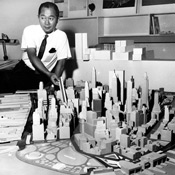

Minoru Yamasaki
“The World Trade Center is a living symbol of man’s dedication to world peace...beyond the compelling need to make this a monument to world peace, the World Trade Center should, because of its importance, become a representation of man’s belief in humanity, his need for individual dignity, his belief in the cooperation of men, and through this cooperation, his ability to find greatness.”
— Minoru Yamasaki Chief Architect of the World Trade Center Complex,
Remarks at opening ceremonies and dedication April 4, 1973
By the late 1950s the Port Authority of New York and New Jersey began to evaluate plans for a world trade center to serve as headquarters for international trade within the bi-state port. The Port Authority is responsible for the critical transportation infrastructure lying within 25 miles of the Statue of Liberty. In 1961 the Port Authority recommended building the complex in Lower Manhattan, which had not seen the same post-war growth as other areas of the city.
The project specified twelve million square feet of floor area on a sixteen-acre site, accommodation for the Hudson tubes and subway connections, and a budget of under $500 million. The plan was submitted to over a dozen American architects and Minoru Yamasaki and Associates of Rochester Hill, Michigan was commissioned to design the World Trade Center.
Yamasaki considered over 100 different designs before settling on twin towers: one tower became unreasonable in size and unwieldy structurally. Two towers gave reasonable office space on each floor, took advantage of the magnificent views, and allowed a manageable structural system. Only later was it decided to build the towers as the world’s tallest buildings.